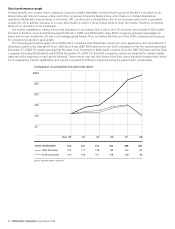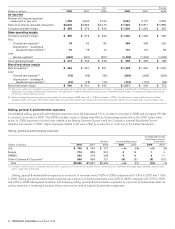McDonalds 2008 Annual Report Download - page 23
Download and view the complete annual report
Please find page 23 of the 2008 McDonalds annual report below. You can navigate through the pages in the report by either clicking on the pages listed below, or by using the keyword search tool below to find specific information within the annual report.
MANAGEMENT’S DISCUSSION AND ANALYSIS OF
FINANCIAL CONDITION AND RESULTS OF
OPERATIONS
OVERVIEW
Description of the business
The Company franchises and operates McDonald’s restaurants. Of
the 31,967 restaurants in 118 countries at year-end 2008, 25,465
were operated by franchisees (including 18,402 operated by
conventional franchisees, 2,926 operated by developmental
licensees and 4,137 operated by foreign affiliated markets
(affiliates)—primarily in Japan) and 6,502 were operated by the
Company. Under our conventional franchise arrangement, franchi-
sees provide a portion of the capital required by initially investing in
the equipment, signs, seating and décor of their restaurant busi-
nesses, and by reinvesting in the business over time. The Company
owns the land and building or secures long-term leases for both
Company-operated and conventional franchised restaurant sites.
This maintains long-term occupancy rights, helps control related
costs and assists in alignment with franchisees. Under our devel-
opmental license arrangement, licensees provide capital for the
entire business, including the real estate interest, while the Com-
pany has no capital invested. In addition, the Company has an
equity investment in a limited number of affiliates that invest in real
estate and operate or franchise restaurants within a market.
We view ourselves primarily as a franchisor and continually
review our mix of Company-operated and franchised (conventional
franchised, developmental licensed and affiliated) restaurants to
deliver a great customer experience and drive profitability. In most
cases, franchising is the best way to achieve both goals. Although
direct restaurant operation is more capital-intensive relative to
franchising and results in lower restaurant margins as a percent of
revenues, Company-operated restaurants are important to our
success in both mature and developing markets. In our Company-
operated restaurants, and in collaboration with our franchisees, we
further develop and refine operating standards, marketing con-
cepts and product and pricing strategies, so that only those that
we believe are most beneficial are introduced Systemwide. In addi-
tion, we firmly believe that owning restaurants is paramount to
being a credible franchisor and essential to providing Company
personnel with restaurant operations experience. Our Company-
operated business also helps to facilitate strategic changes in
restaurant ownership.
The Company’s revenues consist of sales by Company-
operated restaurants and fees from restaurants operated by
franchisees. Revenues from conventional franchised restaurants
include rent and royalties based on a percent of sales along with
minimum rent payments, and initial fees. Revenues from restau-
rants licensed to affiliates and developmental licensees include a
royalty based on a percent of sales, and may include initial fees.
Fees vary by type of site, amount of Company investment, if any,
and local business conditions. These fees, along with occupancy
and operating rights, are stipulated in franchise/license agree-
ments that generally have 20-year terms.
The business is managed as distinct geographic segments.
Significant reportable segments include the United States (U.S.),
Europe, and Asia/Pacific, Middle East and Africa (APMEA). In
addition, throughout this report we present “Other Countries &
Corporate” that includes operations in Canada and Latin America,
as well as Corporate activities. The U.S., Europe and APMEA
segments account for 34%, 42% and 18% of total revenues,
respectively. France, Germany and the United Kingdom (U.K.), col-
lectively, account for approximately 55% of Europe’s revenues; and
Australia, China and Japan (a 50%-owned affiliate accounted for
under the equity method), collectively, account for over 50% of
APMEA’s revenues. These six markets along with the U.S. and
Canada are referred to as “major markets” throughout this report
and comprise over 70% of total revenues.
The Company continues to focus its management and financial
resources on the McDonald’s restaurant business as we believe
the opportunities for long-term growth remain significant. Accord-
ingly, in second quarter 2008, the Company sold its minority
ownership interest in U.K.-based Pret A Manger for $229 million.
In connection with the sale, the Company recognized a non-
operating gain. During the third quarter 2007, the Company sold
its investment in Boston Market. In 2006, the Company disposed
of its investment in Chipotle Mexican Grill (Chipotle) via public
stock offerings and a tax-free exchange for McDonald’s common
stock. As a result of the disposals during 2007 and 2006, both
Boston Market’s and Chipotle’s results of operations and trans-
action gains have been reflected as discontinued operations for all
periods presented.
In analyzing business trends, management considers a variety
of performance and financial measures, including comparable
sales and comparable guest count growth, Systemwide sales
growth, restaurant margins and returns.
• Constant currency results exclude the effects of foreign cur-
rency translation and are calculated by translating current year
results at prior year average exchange rates. Management
reviews and analyzes business results in constant currencies
and bases certain incentive compensation plans on these results
because they believe this better represents the Company’s
underlying business trends.
• Comparable sales and comparable guest counts are key perform-
ance indicators used within the retail industry and are indicative
of acceptance of the Company’s initiatives as well as local eco-
nomic and consumer trends. Increases or decreases in
comparable sales and comparable guest counts represent the
percent change in sales and transactions, respectively, from the
same period in the prior year for all restaurants in operation at
least thirteen months, including those temporarily closed. Com-
parable sales exclude the impact of currency translation. Some
of the reasons restaurants may be temporarily closed include
reimaging or remodeling, rebuilding, road construction and natu-
ral disasters. McDonald’s reports on a calendar basis and
therefore the comparability of the same month, quarter and year
with the corresponding period of the prior year will be impacted
by the mix of days. The number of weekdays, weekend days and
timing of holidays in a given timeframe can have a positive or
negative impact on comparable sales and guest counts. The
Company refers to these impacts as calendar shift/trading day
adjustments. These impacts vary geographically due to
consumer spending patterns and have the greatest effect on
monthly comparable sales and guest counts while the annual
impacts are typically minimal. In 2008, there was an incremental
full day of sales and guest counts due to the leap year.
• Systemwide sales include sales at all restaurants, whether oper-
ated by the Company or by franchisees. While sales by
franchisees are not recorded as revenues by the Company,
management believes the information is important in under-
standing the Company’s financial performance because these
sales are the basis on which the Company calculates and
McDonald’s Corporation Annual Report 2008 21
























